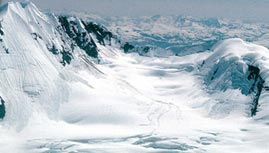Teachers' Domain - Digital Media for the Classroom and Professional Development
User: Preview

Source: National Park Service. Additional images courtesy of Bruce Molnia , U.S. Geological Survey, MODIS Rapid Response Team, NASA/GFSC, and NASA/JPL-Caltech.
Glaciers, which cover about 10 percent of Earth's land surface and hold between two and three percent of its water, are found on every continent except Australia. This interactive activity adapted from the National Park Service offers a comprehensive introduction to glaciers. By exploring the different sections, users will learn where and why glaciers form, what influences their growth and decline, and how an apparently solid mass appears to flow like a river.
Glaciers can form anywhere that snow and ice persist year-round. They grow slowly over thousands of years, as snowflakes from one snowfall are compacted and eventually turn to ice under the weight of subsequent snowfalls.
Although ice is generally perceived to be rigid, glaciers are never stationary. Because the weight of their accumulated snow and ice is so great, gravity actually forces the glacier to spread outward downslope. Glacial movement is responsible for the formation of ice shelves, which extend from the land to the sea surface. It also plays an important role in shaping landscapes. For example, in glaciated terrain, river valleys are eroded by glacial motion, becoming wider and deeper from the flow of glaciers through them.
Glacial ice serves many functions that affect the entire Earth system, including the regulation of global moisture, temperature, and ocean salinity. Because glaciers reflect sunlight, the evaporation rate and surface temperature where they exist are low. As glaciers melt, however, more heat is absorbed by water and land, causing more surface water to evaporate into the atmosphere and surface temperatures to rise.
Explaining the relationship between glacial ice and the third factor, ocean salinity, is more complicated. Sea ice is ice that extends seaward from continental ice sheets each winter and melts each summer. As sea ice extends, pure water is crystallized out of the ocean and salt is left behind, increasing the salinity of the ocean water in the immediate vicinity and making it denser than it would otherwise be. The temperature and density gradient that exists in the ocean waters from the equator to the poles drives ocean circulation. Should icebergs and glaciers melt and spill large quantities of fresh water into the ocean, circulation patterns could change, which could dramatically change global climate.
Global warming's effect on ice could have potentially serious consequences for human societies. In mountainous regions, accelerated glacial melting could produce flooding, followed by a drought that would affect hundreds of millions of people who rely on stable glaciers to supply their water. In polar regions, significant melting of the ice sheets would put the populations of mammals and birds that inhabit the ice sheets at risk. A visual comparison of present-day coastline positions with those from the peak glacial advance 20,000 years ago begins to show how much water is contained in glaciers and the impact accelerated global warming could have, raising the sea level and causing flooding of continental coastlines.
 Loading Standards
Loading Standards Teachers' Domain is proud to be a Pathways portal to the National Science Digital Library.
Teachers' Domain is proud to be a Pathways portal to the National Science Digital Library.
